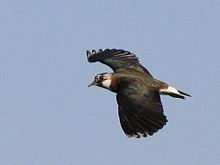Subfamily Vanellinae Rank Genus | Family Charadriidae Scientific name Vanellus Phylum Chordata Order Shorebirds | |
 | ||
Lower classifications Northern lapwing, Southern lapwing, Spur‑winged lapwing, Red‑wattled lapwing, Masked lapwing | ||
Northern lapwing vanellus vanellus full hd close up view
Vanellus is the genus of waders which provisionally contains all lapwings except red-kneed dotterel, Erythrogonys cinctus. The name "vanellus" is Latin for "little fan", vanellus being the diminutive of vannus ("winnowing fan"). The name is in reference to the sound lapwings' wings make in flight.
Contents
- Northern lapwing vanellus vanellus full hd close up view
- Peewit vanellus vanellus lapwing
- Description
- Systematics
- List of species in taxonomic order
- Prehistoric species
- References
Peewit vanellus vanellus lapwing
Description
These long-legged waders mostly have strongly patterned plumage. Although the most familiar Eurasian lapwing, Vanellus vanellus (northern lapwing), has a wispy crest, only two other species do so. Red or yellow facial wattles are a more typical decoration.
Only northern, sociable, white-tailed lapwing, grey-headed and brown-chested lapwings are truly migratory species. The Andean lapwing moves downhill in winter.
Spur-winged, blacksmith, river, southern, Andean and pied lapwings are boldly patterned, red-eyed species with a spurred carpal (wrist) joint.
Many species have wattles which can be small (black-headed, spot-breasted, red-wattled and banded lapwings) or large (white-headed plover, African wattled, yellow-wattled, southern, Andean, Javanese wattled, or masked lapwings). The latter species are the largest of the plover family, since several exceed 30 cm (12 in).
Systematics
The systematics of Vanellus have hitherto resisted clear resolution. Essentially, no major revision can be brought to agree with another, and up to 19 genera were at one time recognized for the 24 lapwings species. While it would certainly desirable to split up this large and diverse genus a bit, the morphological characters are a confusing mix of apomorphic and plesiomorphic traits in any one species, with few relationships readily apparent. Molecular data has been found to provide even less sufficient resolution, though the lapwings have not yet been as thoroughly studied under this aspect as other Charadriiformes.
The only thing that can be said with a fair degree of certainty is that according to the DNA sequence data one group of 5 species seems to stand out. These are wattle-less lapwings which were separated as Anitibyx, Belonopterus, Hoplopterus (in the narrow sense) and Ptiloscelys. They are visually very dissimilar, but it is notable that their distribution forms a clean band through the tropical regions of the world except Australia; they might conceivably form a clade. The only species among them that is migratory is the Andean lapwing (V. resplendens), which as noted above cannot be allied with the truly migratory lapwings on these grounds. However, if these were to be split off, for one thing it is almost certain that other lineages would also require separation; the new genus' name would probably be Hoplopterus, which is the longest- and most widely used alternative lapwing genus.
List of species in taxonomic order
Alternatively placed in Hemiparra:
Alternatively placed in Anitibyx:
Alternatively placed in Hoplopterus:
Alternatively placed in Sarciophorus, Lobivanellus or Hoplopterus:
Alternatively placed in Lobipluvia or Hoplopterus:
Alternatively placed in Xiphidiopterus or Hoplopterus:
Alternatively placed in Stephanibyx or Hoplopterus:
Alternatively placed in Afribyx:
Alternatively placed in Tylibyx, Lobivanellus or Hoplopterus:
Alternatively placed in Anomalophrys:
Alternatively placed in Microsarcops or Hoplopterus:
Alternatively placed in Lobivanellus or Hoplopterus:
Alternatively placed in Rogibyx:
Alternatively placed in Zonifer, Lobivanellus or Hoplopterus:
Alternatively placed in Lobibyx, Lobivanellus or Hoplopterus:
Alternatively placed in Chettusia:
Alternatively placed in Vanellochettusia or Chettusia:
Alternatively placed in Hoploxypterus:
Alternatively placed in Belonopterus:
Alternatively placed in Ptiloscelys or Belonopterus:
Prehistoric species
Species known only from fossil or subfossil remains include:
The last three of these seem to be very closely related to the southern lapwing and all were placed in Belonopterus by the describing authors. If Viator picis, also from the Late Pleistocene of Talara, does not belong to an entirely extinct lineage, it might belong to that group too; it seems too large to be closely related to the smallish pied lapwing.
Neither the Early Oligocene Dolicopterus from Ronzon (France) nor the supposed mid-Oligocene lapwing "Vanellus" selysii of Rupelmonde (Belgium) unquestionably belong here. While their age suggests that they may indeed represent some ancient lapwings, the fossil remains have not been studied for many decades and a review is seriously overdue.
